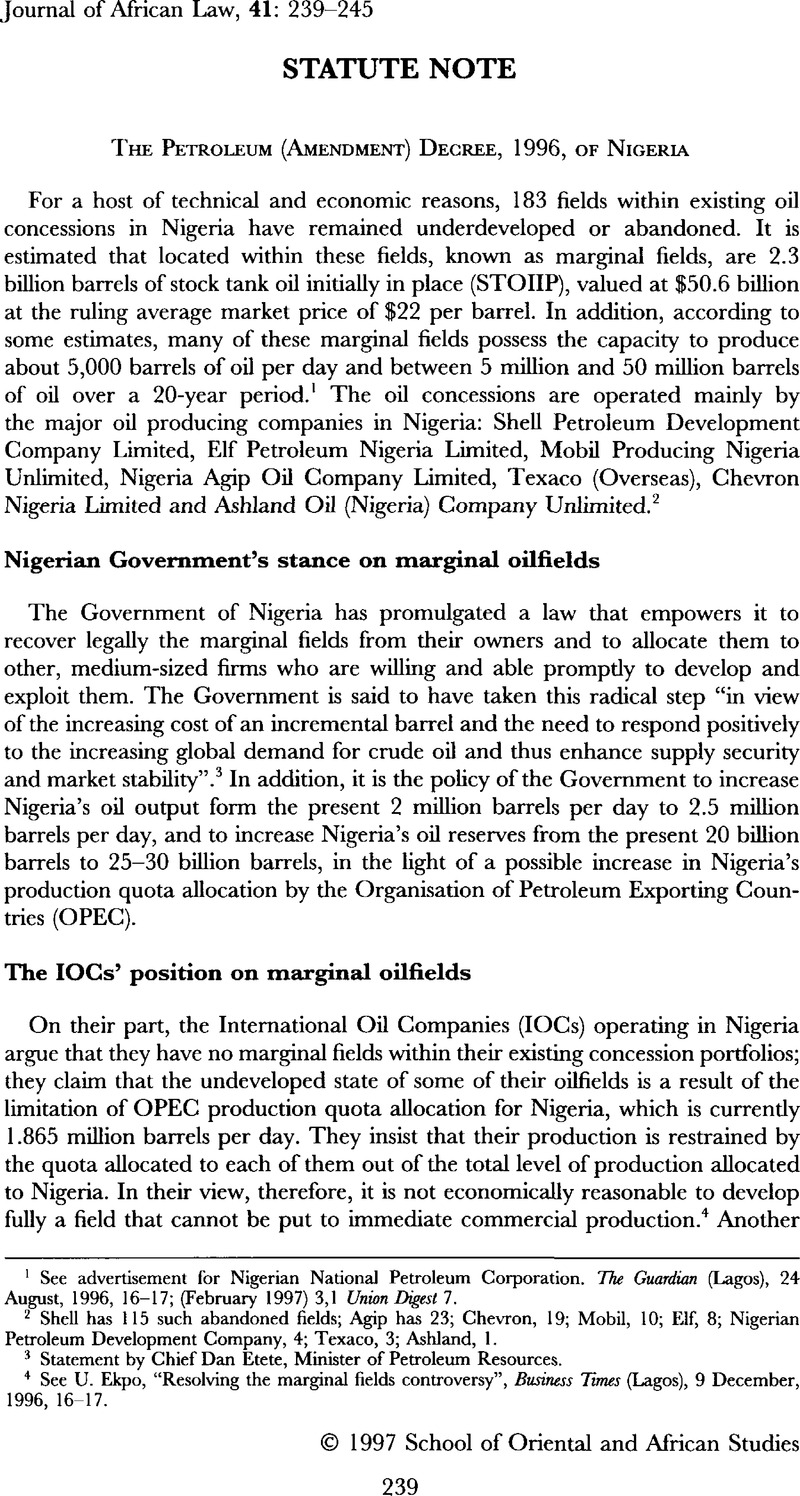Published online by Cambridge University Press: 28 July 2009

1 See advertisement for Nigerian National Petroleum Corporation. The Guardian (Lagos), 24 August, 1996, 16–17; (February 1997) 3,1 Union Digest 7.
2 Shell has 115 such abandoned fields; Agip has 23; Chevron, 19; Mobil, 10; Elf, 8; Nigerian Petroleum Development Company, 4; Texaco, 3; Ashland, 1.
3 Statement by Chief Dan Etete, Minister of Petroleum Resources.
4 See Ekpo, U., “Resolving the marginal fields controversy ”, Business Times (Lagos), 9 December, 1996, 16–17.Google Scholar
5 Omalu, M.K., “Developments in petroleum exploration and production arrangements in Nigeria”, [1996] 2 O.G.L.T.R. 70–76.Google Scholar
6 Adigun, T., “Government favours local firms to get marginal oilfields”, The Guardian (Lagos), 4 November, 1996, 1–2.Google Scholar
7 These mature (marginal) oilfields have production problems such as high water production and diminished inflow performance: therefore IOCs in Nigeria are utilizing several methods to optimize output, including drilling of additional wells and workover of existing wells; see T. Adigun, “Oil firms devise strategies to meet production capacity”, The Guardian (Lagos), 30 September, 1996, 40; additionally, the employment of new technologies will decrease the cost of producing, and thereby make it economically viable to produce from these mature oilfields; such new technologies include three-dimensional seismography, sum hole drilling, horizontal drilling, multi-phase flow technologies, lightweight wellhead platforms, and floating and re-usable production systems; see also “Schlumberger revolutionizes logging technique”, Nigeria's Oil & Gas Monthly, February/March 1996, 16–18.
8 Adigun, T., “High oil prices, low sectoral investments”, The Guardian (Lagos), 16 December 1996, 13.Google Scholar
9 Adigun, T., “Firm takes over Chevron's abandoned oilfields”, The Guardian (Lagos), 11 June, 1996, 40Google Scholar; see also Akinjide, A., “Why oil companies do farm-outs and farm-ins (1 & 2)”, The Guardian (Lagos), 4 March, 1997, 35Google Scholar; 11 March, 1997, 30.
10 Cap. 320 of the 1990 ed. of die Laws of the Federation of Nigeria.
11 Para. 16 of die First Schedule to the Petroleum Act.
12 Supplement to Official Gazette Extraordinary of the Federal Republic of Nigeria, No. 40, Vol. 83, 14 August, 1996, A267–68.Google Scholar
13 Para. 16A(2) of the First Schedule to the Petroleum Act.
14 Ibid., para. 16A(4).
15 Ibid., para. 16A(4).
16 Ibid.; Daintith & Willoughby, United Kingdom Oil and Gas Law (2nd ed.), define a farm-out as follows: “A farm-out is an agreement whereby a third party agrees to acquire from one or more of the existing licensees an interest in a production license, and in the operating agreement relating to it, for a consideration which, in oil industry practice, will normally consist of the carrying out of a specified work obligation, known as the earning in obligation, used in the drilling of one or more wells” and the United Kingdom Department of Energy Press Release of 27 November, 1990, entitled New Statement on Guidelines for Oil and Gas Farm-in Deals, defines farm-ins as “the oil industry term for deals where a company, not at present a licensee on a particular licensed area, can acquire an interest from one of the existing licensees. The transfers of interest are generally made in return for exploration or other commitments, for exchanges of licence interests, or for cash.” See also Akinjide, op.cit., n.9.
17 See n. 9 above.
18 See Shaw, M.N., International Law (3rd ed.), 1991 521–24.Google Scholar
19 See n. 22 below.
20 Hereinafter referred to as the Guidelines.
21 S. 2.0 of the Guidelines.
22 S. 4.0 of the Guidelines.
23 Emole, C.E., “The interrelationship of law and policy in the petroleum industry in Nigeria”, [1997] 3 O.G.L.T.R. 1–9.Google Scholar
24 Omotola, J.A. (ed.), Environmental Laws in Nigeria Including Compensation, Lagos, 1990;Google ScholarAjomo, M.A. and Adewale, O., Environmental Law & Sustainable Development in Nigeria, Nigerian Institute of Advanced Legal Studies/The British Council, 1994.Google Scholar
25 S. 5.0 of the Guidelines.
26 See Petroleum Profits Tax Act, Cap. 354 of the 1990 ed. of the Laws of the Federation Nigeria.
27 Adeputun, S. and Audifferen, Y., “Production sharing contracts: the Nigerian experience”, [1995] 2 O.G.L.T.R. 76.Google Scholar
28 Adewale, O., “Abandonment in the Nigerian petroleum industry”, (1991/1992)1 Bendel State University Law Journal, 88 and 92.Google Scholar